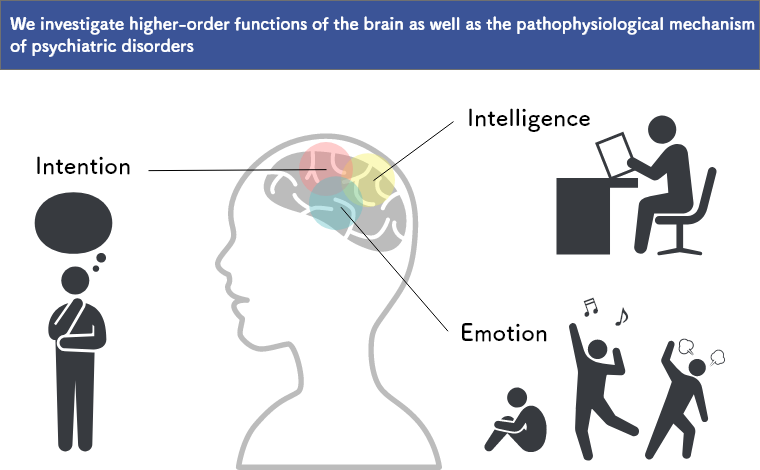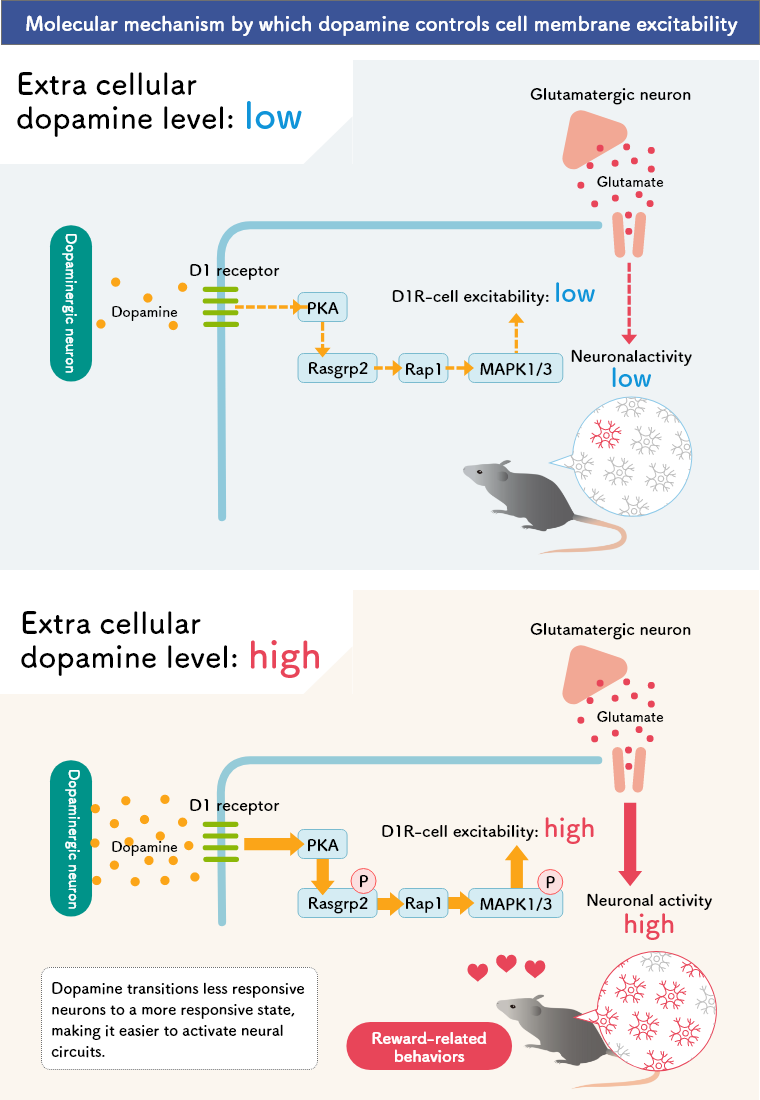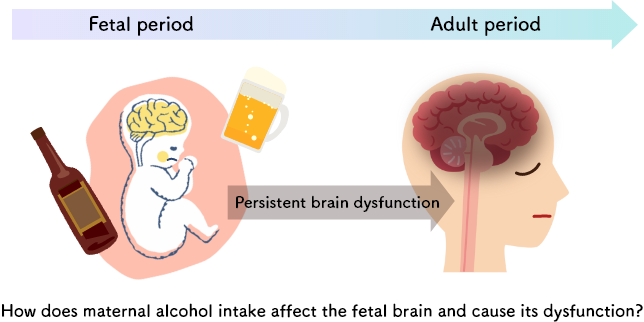Research
Research Projects
We are performing basic research under the theme of "study of mechanisms regulating higher brain function and elucidation of the molecular basis of psychiatric disorders". Mental activities, such as intelligence, emotions, and intention, are brain functions that are indispensable in the process of human life, and the balance of these functions creates diverse personalities. Brain areas responsible for these brain functions have been identified and information regarding neural circuits has gradually been accumulated.
On the other hand, cells maintain their own system without disruption by precisely sensing/controlling the internal and external environment. The typical mechanism of this sensing/controlling is signal transduction through protein phosphorylation. The mechanism by which signal molecules regulate neuronal excitability and plasticity leading to brain function has gradually become clear. However, there are still many points that have not been elucidated.
Based on experimental methods of behavioral pharmacology, our research team investigates higher-order functions of the brain and the pathophysiological mechanism of psychiatric disorders at multiple levels, from molecules to cells, circuits, and individuals. Our final goal is to develop novel treatments/drugs for mental illness, including drug addiction, intellectual disability, and schizophrenia.

Major research topics
(1) Molecular mechanism of drug addiction
(2) Pathological mechanism of fetal alcohol spectrum disorders
(3) Molecular pathology of psychiatric disorders and development of novel therapeutic drugs
(1) Molecular mechanism of drug addiction
Drug dependence is defined as a psychiatric state of patients characterized by psychobehavioral changes, such as compulsions to take a drug, even though they know its side effects. It is presently difficult to prevent the relapse of drug abuse. In terms of drug dependence, investigating the molecular mechanisms and neurocircuits associated with drug-seeking behavior and therapeutic strategies is an urgent task. Addictive drugs, such as cocaine and methamphetamine, increase extracellular dopamine in the nucleus accumbens (NAc), which plays an essential role in reward circuits, and alters the neuronal excitability and synaptic plasticity of dopamine D1 receptor-expressing medium spiny neurons. We recently developed a novel comprehensive phosphoproteomic analysis method and database that enables us to understand phosphorylation signaling. We revealed that the D1R-PKA-Rap1 (low-molecular-weight G protein) - MAPK-K+ channel pathway and MAPK-Npas4 (transcription factor) pathway play important roles in cell excitability and synaptic plasticity, respectively (Neuron 2016; Cell Rep 2019). Our current research themes are "how is the reward memory created in the brain?" and "is it possible to treat drug addiction by controlling the reward memory caused by addictive drugs?".
 Nagai et al. Neuron 2016; Nagai et al. TIPS 2016
Nagai et al. Neuron 2016; Nagai et al. TIPS 2016
(2) Pathological mechanism of fetal alcohol spectrum disorders
Alcohol ingestion by pregnant mothers adversely affects fetal brain development and causes long-lasting brain dysfunction until adulthood. The impairment is generally referred to as fetal alcohol spectrum disorders (FASD) and presents as lifelong symptoms such as learning disabilities, attentional deficit, and cognitive and behavioral disorders. However, the pathogenic mechanism of FASD is still unclear and there is no effective treatment at present. We developed FASD model mice to investigate the mechanism by which brain dysfunction is caused.
Pathological mechanism of fetal alcohol spectrum disorders

(3) Molecular pathology of psychiatric disorders and development of novel therapeutic drugs
Schizophrenia is a psychiatric disorder that presents with positive symptoms such as hallucinatory delusions, poor conversation and expression, negative symptoms characterized by lack of motivation, and cognitive dysfunction such as memory and concentration deficit. Its prevalence is approximately 1% of the general population.
Genetic epidemiological studies, such as adoption studies and twin studies, suggested that multifactorial genetic factors and environmental factors during perinatal events, such as maternal viral infection, are significantly involved in the development of schizophrenia. We analyzed animal models based on environmental factors (Glia 2013; Brain Behav Immun 2014) and genetic factors (Hum Mol Genet 2011; Transl Psychiatry. 2020) involved in schizophrenia, and found several molecules controlling neural development and function. We are also investigating other mental illnesses such as bipolar disorder.
